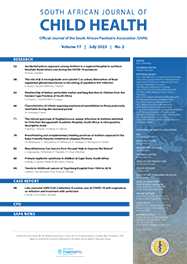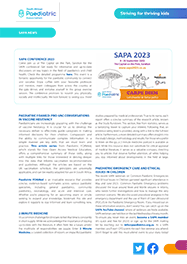Research

Fanconi Anaemia in South African Patients with Afrikaner Ancestry
Abstract
Background. Fanconi anaemia (FA) is a rare genetic disorder of impaired DNA repair that results in physical and haematological consequences in affected individuals. In South Africa (SA), individuals with Afrikaner ancestry are at an increased risk of inheriting disease-causing FA mutations, owing to the three common FANCA (FA, complementation group A) founder mutations present in this population subgroup.
Objectives. To describe the physical phenotype of SA patients with FANCA mutations for the purpose of recommending appropriate care for affected individuals.
Methods. A structured clinical examination and file-based review were used to evaluate the physical phenotype of 7 patients with compound heterozygous and homozygous FANCA founder mutations, and 1 patient with confirmed FANCA complementation analysis. Descriptive statistical analysis was used to determine the frequency of physical anomalies in Afrikaner patients and to compare the described phenotype to other FA cohorts, including a previously clinically characterised black SA FA cohort.
Results. An earlier age of diagnosis of FA in Afrikaner patients, a high frequency of somatic anomalies and a higher-than-expected incidence of the VACTERL/H phenotype were noted.
Conclusions. Based on our findings, recommendations for the care of FA patients with Afrikaner ancestry are made, including renal ultrasound evaluation at diagnosis and hearing screening
Authors' affiliations
C Feben, Division of Human Genetics, National Health Laboratory Service, and Division of Human Genetics, School of Pathology, Faculty of Health Sciences, University of the Witwatersrand, Johannesburg, South Africa
T Haw, Division of Human Genetics, National Health Laboratory Service, and Division of Human Genetics, School of Pathology, Faculty of Health Sciences, University of the Witwatersrand, Johannesburg, South Africa
D Stones, Department of Paediatrics, Universitas Hospital; and University of the Free State, Bloemfontein, South Africa
C Jacobs, Unitas Hospital, Pretoria, South Africa
C Sutton, Department of Paediatrics, Polokwane Mankweng Hospital Complex, Polokwane and University of Limpopo, Polokwane, South Africa
J Kromberg, Division of Human Genetics, National Health Laboratory Service, and Division of Human Genetics, School of Pathology, Faculty of Health Sciences, University of the Witwatersrand, Johannesburg, South Africa
A Krause, Division of Human Genetics, National Health Laboratory Service, and Division of Human Genetics, School of Pathology, Faculty of Health Sciences, University of the Witwatersrand, Johannesburg, South Africa
Full Text
Cite this article
Article History
Date published: 2017-10-05
Article Views
Full text views: 1418

.jpg)



Comments on this article
*Read our policy for posting comments here